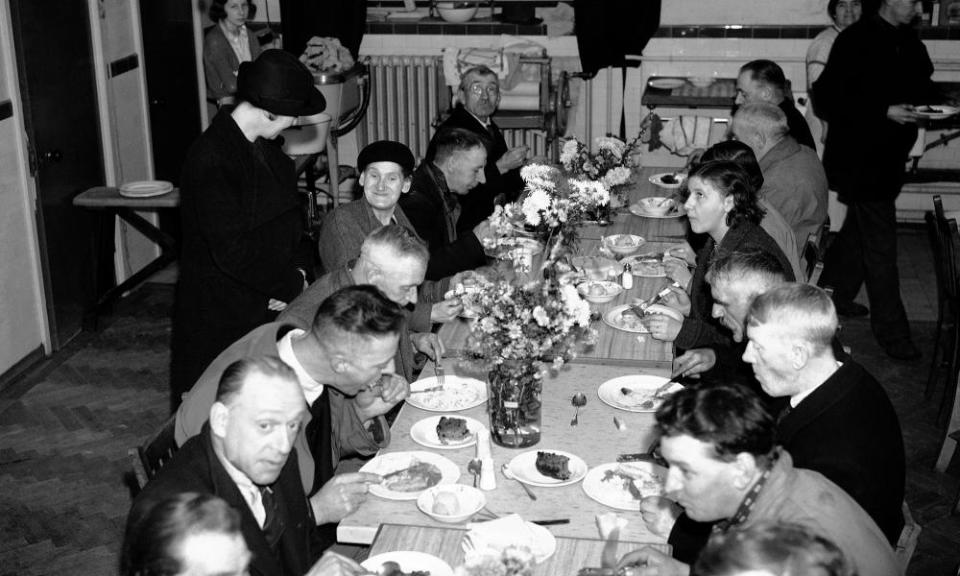What if restaurants continued to feed local communities after lockdown lifts?

In the last three months, restaurants have executed more pivots than an episode of Strictly Come Dancing – cooking for the homeless and NHS staff, selling local produce, putting a halt to one-off £70 pop-ups.
Yet as restaurants start to reopen next month in a socially distanced format, most kitchens are likely to return to their regular routine, just with a bit more outdoor seating and perspex partitions, gracefully pivoting back from their newfound social commitments. But there is still hope that some restaurants will cling to this renewed focus on community in a post-coronavirus landscape.
In a country where a privileged group of people save labour time by eating at restaurants while others rely on food banks, the need for alternative modes of catering has taken on new resonance. Not only should access to healthy, nutritious food be a universal right, but social eating can be a solution for those reliant on mutual aid networks, whether they are elderly, disabled, vulnerable or simply lonely.
An example of this approach is the National Food Service (NFS), started in Sheffield two years ago, which aims to create a free-at-point-of-use social eating hub, run by local communities, in every UK neighbourhood. Since March, branches have had to switch to a takeaway and delivery model and have convinced local restaurants to join the scheme. Some restaurants are now planning to make it a permanent feature of their business model. This would involve not just supplying surplus food to NFS branches, but transforming their lunch services into contribute-what-you-can social eating spaces, subsidised with the profits they make from their dinner service.
The community-owned structure of NFS not only gives those being served food more agency in making sure the meals they are given are appropriate in terms of culture, nutrition and dietary requirements, but avoids the stigma that food banks have. According to Carys Kettlety, co-founder of Bristol NFS, the way the system works means there is “no segregation between rich and poor, working and non-working, deserving and undeserving”.
At Granville Community Kitchen in Kilburn, co-founder and food campaigner Dee Woods has provided home-cooked food to local residents every Friday for the past six years in the form of communal dinners. During the pandemic, demand for food has spiked – and she’s had to step up deliveries to two or three times per week, enlisting the help of some local restaurants. But not all contributions have been helpful, or taken into account that food poverty in London disproportionately affects black people and other people of colour.
“There’s a complete lack of culturally appropriate food,” Woods told me. “The attitude of some chefs needs to change; they shouldn’t think that because people are poor and they’re hungry they will eat anything.” Woods believes restaurants can play a role in solving the problem of food access, but that it will require a form of collaboration that divests power from the chef and moves on from restaurants simply sending on their surplus, with menus “co-created with a community”.
The elephant in the room in all this is the role of the government. State-mandated food has always had a bad rep in the public consciousness, from turkey drummer school dinners to Soviet stolovayas. But the answer isn’t to nationalise Wetherspoon’s. When Beveridge and Bevan created the NHS they did not magic it from nothing, but relied on existing structures, fleshing them out with funding and facilities. Similarly, many food justice projects already exist – from community kitchens and food-buying co-operatives, to communal food-growing in gardens and farms. Each one is already tailored to the needs of its community – all they would need is more chefs and volunteers, as well as local authority funding.
In previous times of economic crisis, community food hubs have provided vital lifelines to communities in the form of canteens. In 1940 the minister for food, Lord Woolton, drew up plans for “communal feeding centres” run by local authorities to supply hot food for those unable to afford restaurants. The name, in its evocation of other things that start with ”commun”, raised the government’s hackles. Ultimately it was Churchill who, in a branding masterstroke, came up with “British Restaurants”. By 1941 they were feeding over half a million people per day, introducing the working class to the idea of dining out – and presaging the democratisation of restaurants.
Almost 30 years later in California, the Black Panthers organised to provide free school breakfasts for impoverished children, eventually expanding the programme to 23 cities and 20,000 children. The legacy of these projects, whether grudging or revolutionary, was not so much in how many mouths they fed, but in the conversations they started over access to food. Six years after the Panthers scheme, the government finally introduced free school breakfasts.
The NFS and Granville are today’s lodestars, continuing to steer these conversations about whether access to good food is a privilege or something that should be a basic tenet of a healthy society. In diaspora restaurants that give immigrants access to their home foods, in working-class cafes that serve communities and offer OAP discounts, in street food vendors like Faye Gomes in Elephant and Castle who provide hot food to the homeless, restaurants have shown that they are already part of this conversation. As lockdown eases, they must not pivot away from it.
• Jonathan Nunn is a food writer based in London. He edits the food newsletter Vittles

